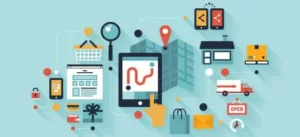Multichannel e-commerce is also called Multichannel retailing. It is the use of many channels to reach customers. Such channels include physical retail stores, e-commerce stores, telephone sales, social media sales and any other method that can attract a customer to purchase a product.
One common mistake that many online retailers make is that they put all their budget and efforts in building a great website. E-commerce transactions do not only include the customer purchasing an item but also involves the customer browsing, choosing, buying then receiving the product and maybe even returning it. In multichannel retailing having a good logistics specialist is as important as your store, to take care of the pre and post-sale services.
When the basics are in place retailers should concentrate on driving traffic to their website. Most retailers focus on one source of traffic and that is search engine optimization. This is the best means of generating traffic but for effective multi-channel e commerce you have to do what the name implies, use multi channels.
The most common e-commerce channels are
Direct traffic
It includes email marketing (direct and transactional ), direct URL navigation and social bookmarking. Although this method is losing on popularity, it is still a good method to generate traffic.
Paid search
It means buying traffic from search engines (e.g. Google and Bing) on pay per click basis (PPC). This is a reliable SEO tool to drive traffic to your website. Paid search requires you to maintain the creation and management of keywords, it also is one of the more expensive methods
Comparison shopping Engines (CSEs)
There are hundreds of comparison shopping engines based on different business models. The more popular free option is Google Product Search, but you need a successful SEO strategy to benefit from this search. There is also pay per click advertising or paid sites like shopping.com. CSEs drive traffic to your website and have high conversion rates.
Marketplaces
Marketplaces are the sites that allow you to offer your items for sale. Many social sites, like Facebook or Instagram, are turning into marketplaces, allowing you to sell your products and receive payments with a simple click.
You need a good strategy to attract potential customers but since consumers spend a lot of time on social media, and the purchasing of goods is so easy, you can increase sales considerably. But you will not attract consumers to your site.
Social media
Social media is an effective and cheap method to increase product awareness and attract customers to your brand or shop.
The majority of retailers do not take advantage of the potential and return on investment social channels offer. Even the smallest business can make a big impact with a small budget.
Important things for online retailers
Don’t focus on free things
TANSTAAFL: There ain’t no such thing as a free lunch
Everything has a price, if you are using something for free then you are paying for it somewhere else.
Diversify
Don’t depend on one channel like pay per click or Instagram. Consumers follow new trends everyday and all platforms are corporations working for money, they can change their algorithms or policies as they will.
Sticking to one platform, or channel, will make you dependent and put you at risk of losing everything. Diversify to reach more potential customers and spread your risk.
Build a portfolio of e-commerce channels
It means retailers should maintain a portfolio of all channels to decide which channel gives a larger return for which product or campaign type.
This will help you focus marketing campaigns, reduce costs and increase your profit margin.
Put your products everywhere
We know consumers usually have a favorite shop, their first to go place when they want to buy something. Retailers should have a broad presence just in case they don’t find what they are looking for and start searching the net, that is the best opportunity to win customers.








